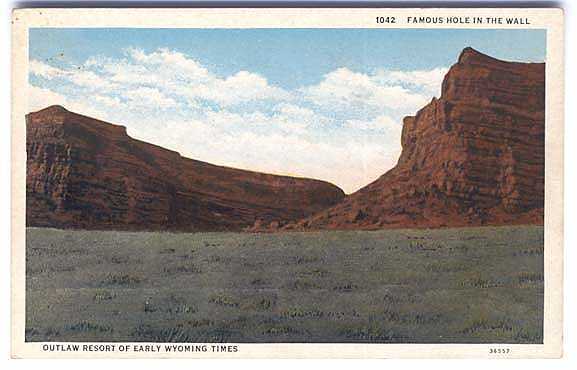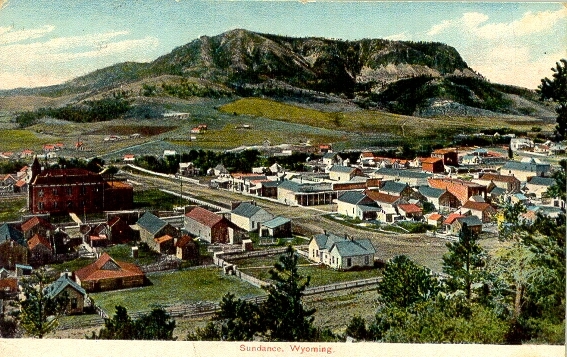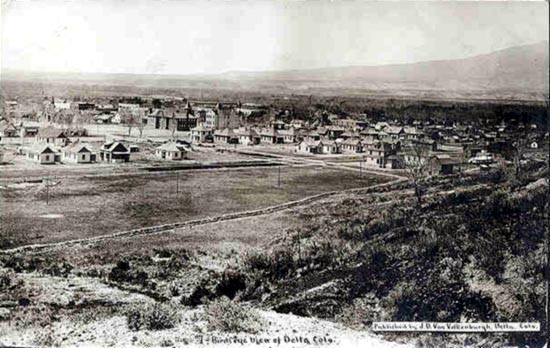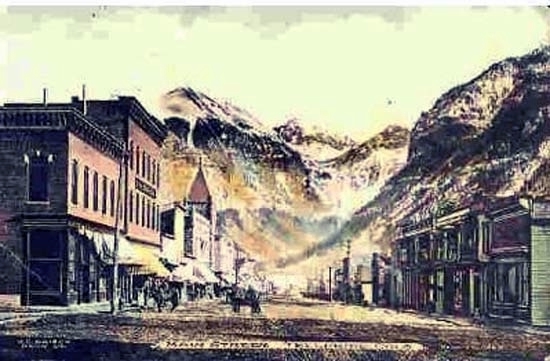
Hole-in-the Wall, drawing by Merritt D. Houghton, approx. 1900.
For Discussion of Houghton, see Encampment.
In Southwest Johnson County and extending into Natrona County is an
escarpment of red sandstone known as the "Red Wall." In fifty miles, it is
broken only by one deep vee-shaped canyon
which at the far end narrows into a funnel shape and provides the only access fron the east to a
verdant valley. From the north, access could be obtained through the Bar C Draw to Buffalo
Creek. Both the valley, lying between the Red Wall and the Big Horn Mountains to the
west, and the canyon are called the "Hole in the Wall." The area was (and still is) isolated.
When in 1886 Pushroot Jim, a nighthawk for the Bar LX, was murdered, it took a day and a half
to get to Buffalo to notify the Sheriff and an equal time to get back.

Entrance to the Hole-in-the Wall
In this area in the 1880's and the 1890's, rustlers
would graze stolen cattle and would provide refuge to outlaws. Thus, inhabitants of
the six cabins that stood in the valley were known as the "Hole in the Wall Gang." Members of the
gang included Bob Smith, Al Smith, Bob Taylor, George Currie, Tom O'Day, and the Roberts Brothers.
Others who passed through the Hole in the Wall included Robert Leroy Parker (Butch Cassidy), Harry Longbaugh
(the Sundance Kid), and Harvey Alexander Logan (Kid Curry). Jesse James is also
reputed to have visited the Hole in the Wall.

Cabin, Hole-in-the-Wall, 1914.
 Robert Leroy Parker, Butch Cassidy, 1893, Wyoming State Penitentiary Photo, Laramie
Robert Leroy Parker, Butch Cassidy, 1893, Wyoming State Penitentiary Photo, Laramie
Robert Leroy Parker (1866-1908?) was the son of devout Mormons. Parker was
led into the life of crime by Mike Cassidy, from whom he adopted the name "George Cassidy." One
explanation sometime given for the name change is that he did not wish to bring shame on his
family.
Mike Cassidy was involved in rustling, but he ultimately disappeared after killing a
Wyoming rancher. In 1885, Parker was employed by Charlie Crouse. Crouse operated a
ranch in Brown's Hole and a butcher shop in Rock Springs in which it is
alleged that he sold meat from rustled cattle. From this employment, it is
contended that Parker derived the nickname "Butch." By 1886, Parker was living near Meeteetse under his real name. It is believed that
he participated in the robbery of the San Miquel Valley Bank in Telluride on June
24, 1889 (see photo at bottom of page). The Telluride robbery saw the introduction of a new tactic used by
members of the Wild Bunch in subsequent robberies. Along the escape route, the robbers would station fresh horses.
As they made good their escape they would switch the tired horses for the fresh ones. The pursuing posse
would, however, have to continue their chase on tired horses. Thus, the robbers would be
able to elude capture. Nevertheless, one member of Sheriff Baty's posse almost caught up with
the Telluride robbers, but then found himself in the urgent need to stop and
relieve himself, permitting the robbers to escape.
Parker continued to engage in rustling in Wyoming. At the instance of Otto Franc, owner of the
Pitchfork near Meeteetse, he was arrested for horse stealing and sentenced in 1894 to the State
Penitentiary, then in Laramie. He was released six months early in January 1896. He then returned to a life of crime using a
series of hideouts including Robbers' Roost in southern Utah, Brown's Hole in northwest
Colorado, and the Hole in the Wall.

Sundance, Wyoming, approx. 1907
 Harry Longabough (the "Sundance Kid") and Etta Place, January 1901, photo by
DeYoung Photograph Studio
Harry Longabough (the "Sundance Kid") and Etta Place, January 1901, photo by
DeYoung Photograph Studio
The photo to the left was taken of Harry Longabough and Etta Place by the
DeYong Photograph Studio which was then located at 826 Broadway, New York. Shortly thereafter,
Longbough and Place left for Argentina, traveling under the name of Mr. and Mrs.
Henry Place. 826 Broadway is now the location of a large used bookstore. The studio later
moved to Broadway and 17th.
Harry Longabough, also sometime spelled Harry Longbough or Longenbough,
was born in Pennsylvania in 1867. At an early age, he moved with his family to
Colorado. By age twenty, he was working as a cowboy for the N Bar N owned by the
Neidringhaus Brothers in Culbertson, Montana. For a period of time, he was
also reputed to have worked for the Two Bar. In 1887, out of work and drifting,
Longbough stole a horse, gun, and saddle from Western Ranches, Ltd., owner of the
Three V's, near Sundance, Wyoming. He was ultimately arrested, plead guilty, and
was sentenced to 18 months in the Sundance Jail. He was pardoned by Gov. Thomas Moonlight in Feb. 1889.
Longbough drifted then to Belle Fourche, S.D. There, as a result
of his bravado about the time spent in the Sundance Jail, he earned the
appellation of Sundance or "Sundance Kid."
From there he moved north of the border and worked for a period of time at the
Bar U in Alberta and engaged for a short period of time in the saloon business at
Grand Central Hotel in Calgary. He then returned to Montana again signing on with the
N Bar N at its Rock Creek unit.
In 1892, Sundance was implicated with Tom McCarty (whom Sundance had known in Colorado), Matt
Warner, and George Cassidy (Butch), in the robbery of the Great Northern westbound # 23 near
Malta, Montana. The following year, McCarty was involved in the robbery of the Farmers and Merchants Bank in
Delta, Colorado. On September 7, 1893, Tom McCarty and his brother Bill McCarty entered the bank.
Outside, Bill's 17-year old son held the horses. Outside of town other fresh horses had
been stationed by the trio. The cashier,
A. T. Batchley, refused to turn over money and was shot and killed by McCarty. The sound of the
shot aroused citizenry outside who gave the alarm. Across the street, W. Ray Simpson grabbed a
repeating rifle. In the fusilade of bullets, both Bill and his son Fred were killed. Tom made good
his escape with apparently $100.00 of the money from the bank.

Delta, Colorado, approx. 1910
Tom then disappeared. Three
years later Tom sent an account of his adventures to a friend together with a threat to kill Ray Simpson. Simpson's
response was to send to a newspaper a small piece of cardboard perforated with ten bullet holes within the
space of a fifty-cent piece. The holes had made from a distance of 225 feet. No attempt on Simpson's life was made
and McCarty totally disappeared never to be heard from again. [Writer's note: Writer Norman Davis,
Jailbirds & Stool Pigeons, Crime Stories of the West, Hancock House Publishers, Blaine, WA, 1999, contends that
Tom McCarty changed his name to John McCarty and that his last heist was rolling a drunk in a hotel in
Price, Utah. According to Davis, McCarty committed suicide in 1918 by drowning himself in a bathtub in a
Denver flophouse.] By 1896, Sundance was
reported to be in the Baggs and Dixon, Wyoming area.

Telluride, Colorado, 1911
Next page: Butch Cassidy, Sundance Kid continued, the Butte
County Bank robbery, Ben Kilpatrick, Harvey Logan, Charles Siringo.
|